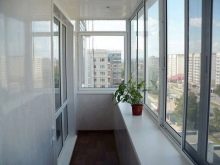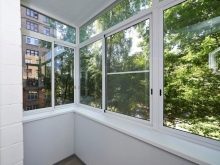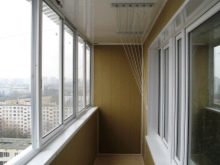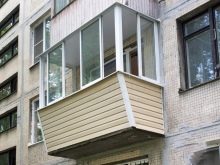Loggia glazing is an opportunity to protect it from wind, rainfall, hail, bird visits. In addition, glazing allows you to make the space more comfortable, warm. There are 2 glazing technologies - cold and warm. The first one will be discussed.



What it is?
Cold glazing is a modern alternative to independent glazing that existed in the Soviet period. Of course, today's technologies and materials allow you to do better work, get a more attractive and durable result. Window construction is usually based on aluminum profiles and glass, this is the most common option. Cold glazing is a balcony protection with single glass window openings. The main objective of the design is protection against snow and wind.
Thereby the temperature inside the balcony is slightly higher (about 5 ° C) than on the street. However, one cannot count on a warmer “climate”. The thermal conductivity of aluminum (the metal base of the structure) is high, so its temperature will be the same as the ambient temperature. That is why the balcony was called "cold."
Due to temperature features, it is convenient to operate it only in the warm season, and therefore such a balcony has another name - “summer”.



Advantages and disadvantages
One of the advantages of cold glazing is the lower cost of designing such a balcony compared to warm. This is due to the installation of sliding aluminum windows, whose sashes do not open in the manner of a door, but move apart.Such window profiles are cheaper, and it is the installation of windows, as well as the design itself, that is usually the lion's share of the balcony repair budget.
In addition, the aluminum sliding profile has a lower weight compared to warm windows, which can be a decisive factor when choosing the type of cladding. On old and dilapidated structures, the installation of massive windows may be prohibited. So cold glazing is often the only option for residents of old houses with weak base plates.
Savings occur at the stage of cladding. A warm balcony involves the use of heat-insulating materials, which also increase the size of the estimates for the balcony. If we talk about sliding cold frames, then their wings do not swing open, but disperse in the manner of the doors of a sliding wardrobe. This makes it possible to save space, which is important for small balconies.



From the advantages we turn to the "minuses" of cold glazing. They follow from the features of the room. Aluminum frames are not able to retain heat, so the temperature on the balcony is only 3-5 C higher than on the street. This makes it impossible to comfortably use the balcony in the cold season.
Cold glazing is the use of one double-glazed window, the average thickness of which is 4 mm. Naturally, in addition to low thermal insulation properties, such structures also have low noise insulation indicators. Sliding structures have low leakproofness, so such windows can leak in rainy or snowy weather. Finally, in case of temperature differences during cold time (for example, thaw in winter and subsequent frosts), the sliding sashes can freeze, which will make it impossible to open them.



What is the difference from warm?
The main difference between cold and warm glazing is the materials used. For warm balconies, plastic windows with two or three-chamber double-glazed windows are used. Plastic itself retains heat better, and air is pumped between the glass panes, which also helps create a thermal cushion. As a result, the temperature on the balcony in the cold season is 15-17 degrees higher than on the street.
The use of plastic windows implies their best sealing. Water does not penetrate between structural elements due to the tight fit of its elements to each other. And the joints between the windows and the rest of the balcony are reliably sealed. When installing plastic windows, the sound insulation of the room is significantly improved.
If you take care of the use of thermal insulation for walls and floors, the installation of the “warm floor” system, then such a balcony can be turned into a full-fledged living room.



When using cold glazing (even under the condition of warming the walls and floor), this is impossible. Heat losses through the window will be too significant. It is logical that a warm window will be more expensive than cold glazing. Usually, for installation you need to invite a team of specialists. The design itself will be heavier than the cold version.
Some people consider cold glazing a frivolous option, however, this is not the case. A cold balcony is the best solution for those who do not plan to use it for relaxing or living in cold weather. But nothing prevents storing things and preserving, drying clothes or planting flowers on such a balcony.


Varieties
There are several options for cold glazing: without removal and removal. Glazing without removal is carried out on the balcony base itself without removal of the structure beyond. In general, the design is solid, and its installation can be done on its own.
Offset glazing involves the removal of the glass structure beyond the perimeters of the balcony. To do this, special brackets are fixed to the upper and lower parts of the parapet, the length of which is 30-35 cm.The brackets themselves are mounted on supporting bars, and then a metal window sill is installed between the balcony railing and this structure. A package of glasses is already attached to it. This installation method is more time-consuming, involves great physical and financial costs, requires the involvement of specialists.


Depending on the method of opening the windows, cold glazing may involve the installation of sliding or hinged windows. The first move along the guide in the manner of compartment doors. The second swing open like the usual window or door leaf. There is no particular difference between the designs.
Only sliding ones are somewhat cheaper and save space, but they can freeze in cold weather, which makes opening them impossible.


Material selection
Depending on the type of material used, cold glazing can be frameless or using aluminum profiles. The material for the first type of installation is tempered glass that completely covers the balcony and does not involve the use of profiles, partitions and other metal and plastic structures. Thanks to this, the space of the balcony seems airy, weightless.
At its cost frameless cold glazing significantly lower than panoramic glazing, but it allows you to enjoy beautiful views, to let in more sunlight.
Do not worry that frameless glazing will be fragile. Thanks to special technologies, tempered glass is resistant to hail and squally wind.


The second type of balcony involves the use of aluminum profiles, forming a frame for glass. The system is lightweight, corrosion resistant, and able to withstand temperature changes without losing material performance. Due to the ability of the aluminum profile to acquire the desired shape, cold glazing based on it can be used on balconies of various geometries, including those that have a complex geometric shape. Finally, aluminum is an environmentally friendly non-combustible material. It has a concise look, so it fits well into any design.

There is also an option wooden cold glazing. However, it is not popular. Despite the environmental friendliness and external attractiveness, such windows will turn out to be cold and will require constant care, they are susceptible to decay and the appearance of mold, bacteria, insects on the surface. And at the cost of wooden frames are almost the same with plastic windows.

Description of the progress of work
The sequence of work depends on the type of glazing chosen. If this is an option without removal, then installation involves the following stages of work.
- Preparation of the parapet, involving its strengthening (if required), alignment. Other rough finishing work.
- At the stage of preparation for cladding, it is also necessary to calculate the required number of profiles by performing all necessary measurements.
- Then you need to cut all the details in accordance with the measurements made, forming a window structure.
- Assemble the structure and fix it on the parapet or over the railing.
- Check the installation using a level and secure with screws.
- Mount the slopes and fill the joints and gaps with sealant.
- Install window locking systems, handles and other hardware on the installed window frame.


Installation with the removal allows you to slightly increase the useful area of the balcony by increasing the window sill. But the main reason for choosing this system is the inability to perform work without removal of the structure due to the decay of the parapet or railing. The first stage of the work is devoted to the creation of a metal base from remote brackets (length 25-40 cm). They are installed on the side of the balcony parapet and ceiling plinths. The brackets are connected to each other by means of wooden blocks or metal supports.Thus, a strong frame is formed, on which the glazing system then "stands up".
If necessary, the external part of the removal is sheathed by siding. It is better to do this before installing the glazing, since in this case it is usually possible to carry out work from the inside of the balcony. If you carry out the sheathing after the glazing of the balcony, you will have to hire climbers, which will increase costs. After installing the frame, the glazing technology as a whole does not differ from that used for balconies without removal. The parapet is mounted, on it is an assembled window construction. Everything you need is fixed with screws or foamed with sealant.



Frameless glazing also has its own characteristics during installation. The lower profile of this design simultaneously serves as a guide; it is mounted on the parapet of the balcony. The upper profile is also a guide and is fixed to the ceiling plate. In the groove of the lower guides, glass is mounted on special sashes, which can move along the guide.
After installing a cold window construction, you can additionally insulate the glass. To do this, you can stick a special energy-saving film on the glass, which will reduce heat loss by 20-30 degrees. At the same time, it will be cool on the balcony during the hot season, and the walls and things stored on the loggia will be protected from burning out under the influence of ultraviolet rays.


At the sealing stage, you can choose special silicone sealant, also contributing to improving the heat efficiency of the room. As an option - use insulation for finishing floors and walls and sheathe walls with siding. These measures will significantly reduce heat loss, although the balcony will not become really warm after that. Typically, these tricks are resorted to by owners of apartments facing the north windy sides.
Due to significant heat loss through the balcony in the living room it also becomes very cool, so the residents are trying to solve this problem with minimal cost.
The technology for glazing balconies with sliding aluminum windows, see the next video.










